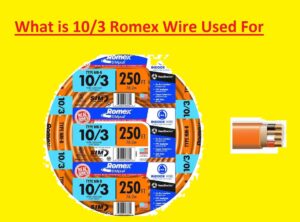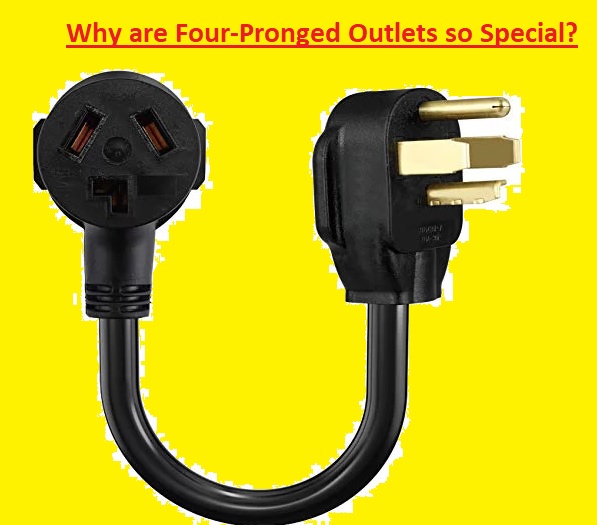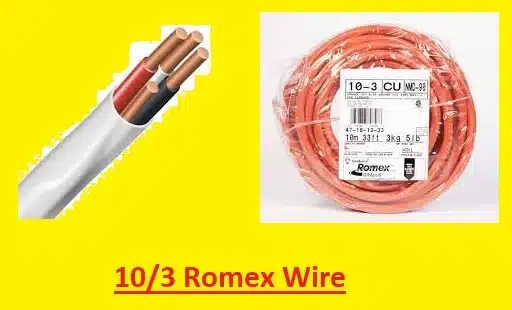Hello readers welcome to the new post. In this post, we will discuss What is 10/3 Romex Wire Used For. In electrical wiring, Rmoex wire is mostly used. There are different options for Romex wire, but 10/3 Romex wire is used due to its features and common use. In this post, we will cover the details of 10/3 Romex Wire and its related parameters. So let’s get started with 10/3 Romex Wire
Introduction to Romex Wire
It is important to know the idea of the Romex wire first. Romex wire electrical wiring brand that is mostly used in residential and commercial uses. There are many conductors in this cable with protection sheets made of non-metallic material. This desing offers simple use and safety that make this brand wire best for electrical uses
What is 10/3 Romex Wire?
Definition
10/3 Romex wire is Romex wire and has the best construction features and electrical parameters. The “10/3” comes with a gauge of the wire and conductors that the wire has. Wire has individual conductors each one has 19 gauge thickness and has a ground wire that makes it 4 wires in the sheath
Construction and Composition
The 10/3 Romex wire has three copper conductors each one is 10 gauge thickness. These conductors are color-coded for easy identification normally red black or white for these three conductors and green for ground wire.
Applications of 10/3 Romex Wire
- Normally used for appliances that needed 20 volts and 120 volts such as dryers. Air conditioners need 240 volts power supply and an additional conductor is unnecessary
- Some more applications are
- Interior walls.
- Garages.
- Above-ground surface wiring.
- Outlets.
- Light fixtures.
- Ceiling fans.
- Electrical panels.
- Light switches
Advantages of 10/3 Romex Wire
- it can carry high current so used for HIGH power applications
- Larger cross-sectional 10 gauge wire decreases resistance and reduces power loss during transmission..
- Used for both residential and commercial applications, best for different electrical projects.
- It has different colors of wires so easily can be identified
- it is long long-duration wire due to construction and 10 gauge wire size and longevity and resistance to wear and tear.
Installation Guidelines for 10/3 Romex Wire
- Make sure the accurate clean wire stripping has an accurate length of conductor for connections.
- Use high-quality connectors to make a strong connection
- Must follow the regulations and electrical codes for installation
- Use proper overcurrent protection devices that are circuit breakers or fuses, to save circuits from excessive currents.
- Accurate ground electrical system to protect for electrical shocks and faults.
- Make sure proper protection from weather before use of wire in outdoor applications
What is 10-3 wire used for
10/3 wires are normally used for wire 220-volt outlets. These outlets provdies power like ovens, electric dryers, and air conditioners. 10/3 wires are also used to wire 120/240-volt outlets, like high power large devices like electric ranges.
Some appliances that can be powered by a 10/3 wire:
- Electric Dryer
- Electric oven
- Air conditioner
- Hot tub
- Pool pump
- Electric car charger
10 2 or 10 3 Wire for Air Conditioners
The first number in wire denotation is the gauge or thickness of the wire, and the 2nd number is non-grounding conductors or wires in the cable.
These cables also come with grounding conductors, that are not added in numbers. Both 10/2 and 10/3 come with ten gauge wire, which is best for some AC systems.
While 10/3 wire comes with 4 conductors and is used in devices that need 240 volts and 120 volts like dryers. Most AC systems have 240 volts power supply and extra conductors are not needed. Since 10.3 wire has not benefits for those who need wiring for ac system. So using 10/3 wire can cause high costs.
Difference between 10-2 vs 10-3 wire
10/2 and 10/3 basic difference is the number of conductors. The 10/2 wire has two conductors and the 10/3 has 3 conductors.
10 is the AWG wire size used in these two wires and is a calculation of wire thickness. 10 AWG is thick and can handle a 30 amp current. The second number 2 to 3 is several conductors in the cable. With conductors, the cable also has a ground wire
Their applications are mostly the same but 10/3 wire is also used where high power is a need like, like ovens, and air conditioners. 10/2 wire used for low-power devices light fixtures, outlets, and switches.
differences between 10/2 and 10/3 wire:
| Feature | 10/2 Wire | 10/3 Wire |
|---|---|---|
| AWG Size | 10 | 10 |
| Number of Conductors | 2 | 3 |
| Maximum Current Carrying Capacity | 30 amps | 50 amps |
| Typical Applications | Light fixtures, outlets, switches | Electric dryers, ovens, air conditioners |
Why are Four-Pronged Outlets so Special?
The older wiring system has 3 ronged wires. These outlets have two hot wires and neutral aires with ground wire. If there is an issue with the device current passes through the neutral wire and the device casues shock.
4 pronged outlets have a third pron that is connected with ground wire. This wire gives a safer path for current to flow if there is a fault in devices. It saves from electrical shock.
4 pronged outer used by NEC for electric dryers and ranges. In older wring that has three-pronged now must have to replace with 4 pronged outlets if you have an electric dryer or range.
Advantages of four-pronged outlets:
- It supported new devices
- It used for operating dryers and ranges
- For protection from shock, it has a dedicated ground wire
What is the Diameter of 10/3 Wire?
The diameter of a 10/3 wire is about 0.1019 inches. it is the value of each three conductors in the cable. The total die dia is 0.66 inches. The 10-in-wire name defines the thickness of the wire defined by AWG. The 10 AWG wire is larger and thicker and carries a 30 amp current.
Is 10/3 Wire Heavy Enough for a Dryer?
Yes, normally we have used the 10/3 w/ground, NM-B, Romex, copper, Thhn. It is good for 30 amp 240-volt duer according to NEC
Voltage Drop of the 10/3 Cable
The voltage loss of a 10/3 cable is defined on length, current in cable, and resistance of the cable. This formally used to measure voltage loss
Voltage loss= resistance x current x length
As we know resistance of 10/3 cable is about 0.003937 ohms per foot. So100-foot 10/3 cable and the current flowing through the cable is 30 amps, the voltage loss is
voltage drop = 0.003937 ohms/foot x 30 amps x 100 feet = 1.1 volts
According to NEC voltage loss for this cable not be more than three percent. So here voltage are according to NEC
Here are some points to reduce voltage loss in a 10/3 cable:
- shortest possible length of cable.
- larger wire size.
- Avoid using cable that is damaged or old.
Can 10/3 Wire Be Run Underground?
Yes, 10/3 wire can be run underground. The underground cable is made of thick gauge wire and has a protective outer cover that is resistant to moisture and sunlight. it must be buried 18 inches deep according to NEC. There must be a conduit used to protect the cable in the ground. Conduit protects cable from damage and corrosion is made of plastic pipe or metals
Here are some points for running 10/3 wire underground:
- correct cable use
- Label the cable so that you use it.
- Bury the cable at least 18 inches deep.
Wire Sizes for Different Air Conditioner Units
| Air Conditioner Tonnage | Maximum Wattage | Amp for 220V | Minimum Wire Ampacity AWG() | Wire Size (AWG) |
| 1.5 Ton | 1,800 | 8 | 10 | 18 |
| 2 Ton | 2,400 | 11 | 14 | 18 |
| 2.5 Ton | 3,000 | 14 | 17 | 14 |
| 3 Ton | 3,600 | 16 | 20 | 12 |
| 3.5 Ton | 4,200 | 19 | 24 | 12 |
| 4 Ton | 4,800 | 22 | 27 | 10 |
| 4.5 Ton | 5,400 | 26 | 31 | 10 |
| 5 Ton | 6,000 | 27 | 34 | 10 |
Can all dryers use 10/3 wire?
If it’s a 120V dryer, use 10/3 wire.If its rating is more than 240V dryer, NO. use 10/3 wiring
Should I use a 10 or 12-gauge wire?
12-gauge is the best option for the bathroom, outdoor receptacles, kitchen, and 120 vols ac. 10 gauge used for cloth dryer, electric water heater supporting 30 amp
How many appliances can you run on a 10/3 wire?
. A 10/3 wire can carry 30 amps of current. So we have three devices of each 10 amp so we can be connected with 10/3 wire.But note that all devices are not operated same time. If you operate three devices at the same wire can overheat
Can we use a 10-gauge wire for outlets?
We can use 10 gauge copper wire for single-phase electrical power rated for 20 amps at 120 volts and 60 hertz frequency
What is 10 3 Romex used for?
The 10/3 wire comes with 4 conductors and is used for devices that need both 240 volts and 120 volts like dryers. Most AC systems need 240 volts power supply and an extra conductor is not needed.
Why use 10 3 instead of 10 2?
The basic difference minimizes the use of additional conductors for 10/3 wire, which is used for circuits that need neutral, such as dryers, and 10/2 operated well for 240 volts devices without using neutral.
Which wire is best for 1.5 ton AC?
Due to factor that its highest curent can be about ten ampere, the wire size for a 1.5-ton inverter ac will be 2.5mm2 or 14 gauge to work properly. This 6mm2 to 10 gauge wire is needed for 3 3-ton AC system that works on a single phase.
Can I use a 10 3 wire for a range?
NM-B Romex is comonly used for electric stoves, ovens, and ranges. 10/3, 8/3, and 6/3 NM-B cables are mostly used. In some conditions, it is the best option for itching wiring. The cables come with an accurate design for wiring kitchen devices and are easily connected.
Can you use 10 3 wire for 30 amp?
Will 10 3 carry 40 amps?
Is 4mm wire good for AC?
What size wire for a 2.5 ton AC?
Can I use 10 3 wire for a 10 2 application?
What is the maximum voltage for 1.5 ton AC?
What size wire for 240v AC?
Can I use 10 2 wire for AC unit?
- 30 Amp Wire Size: What AWG Wire You Need?
- 14 Gauge Wire Amp Rating & Diameter: How Thick is 14 Gauge Wire? 2024 Guide
- What Gauge Wire for 50 Amp Breaker Do I Need?
- HOW MANY AMPS CAN 2 AWG WIRE HANDLE?
- What Size Wire for 200 AMP Service Underground
- How Many Amps is 8/3 Romex Good For – 8/3 Wire Amp Rating
FAqs
- What is 10-gauge 3 wire used for?
it is used for devices that need both 240 volts and 120 volts, such as dryer
- What are Romex wires used for?
Romex is used in residential wiring systems and lighting. Certain types of Romex that is famous fro their nonmetallic sheathing and primary use for branch wiring.
- What is 10-gauge Romex used for?
10/2 NM-B electrical wire used in air voids in tile walls. The value of the voltage rating for 10 Gauge Romex is 600 volts.
- How many amps can a 10 3 wire carry?
A 10/3 wire can carry about 30 amps of current.t
How Thick Is 10/3 Wire?
The dia of a 10/3 wire is about 0.1019 inches. This is the diameter of every one of the 3 insulated conductors in the cable. The total diameter of cable differnt according to the producer, but it is typically about 0.66 inches.









